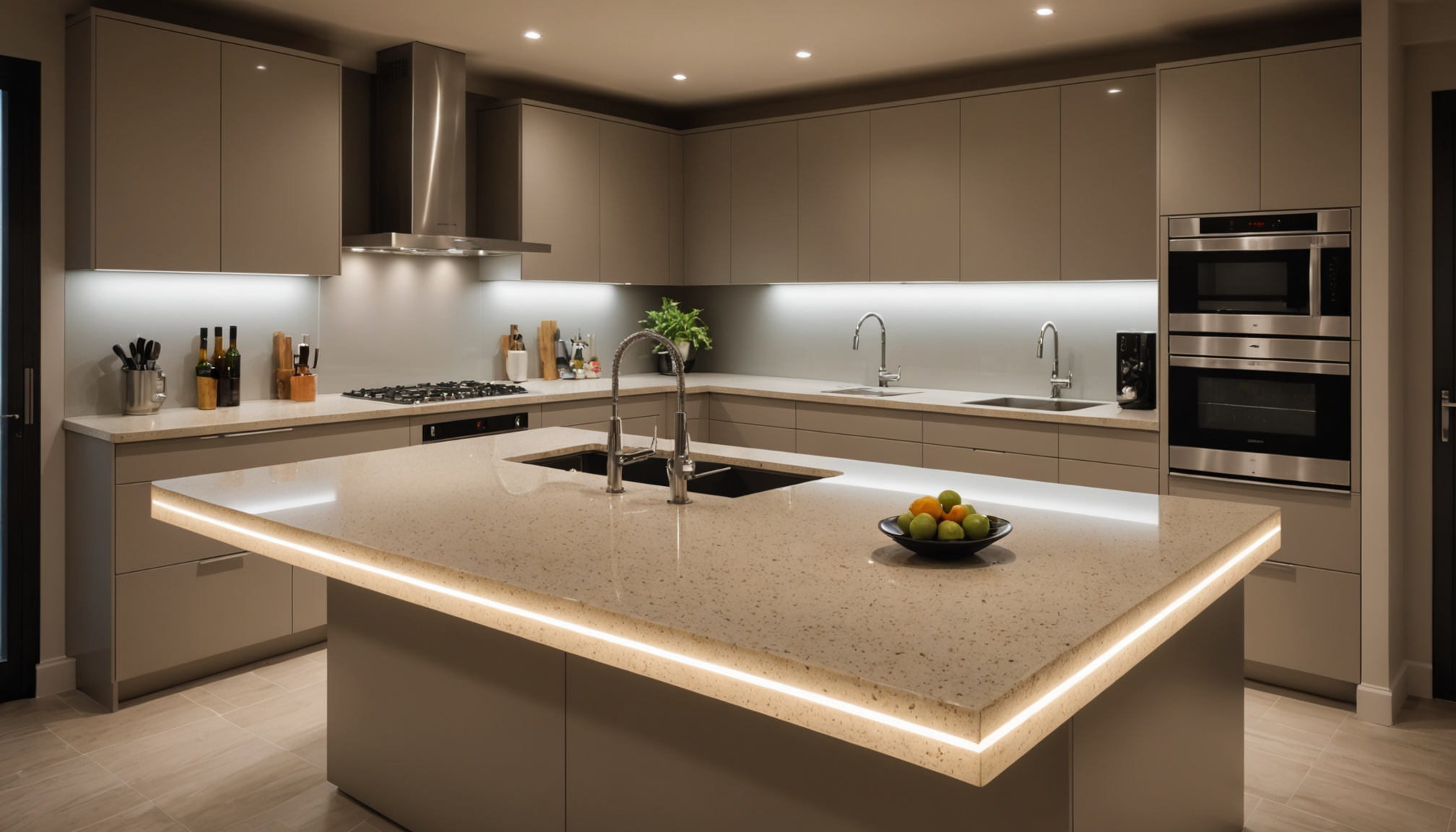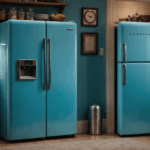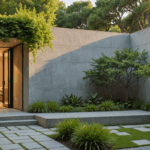In recent years, the countertop industry has seen remarkable advancements in material innovations. These developments have not only revolutionized the design potential for kitchens and bathrooms but have also expanded the functional and aesthetic possibilities for these spaces. While traditional materials like granite and marble remain popular, a wave of new, technologically advanced materials is making significant inroads, offering enhanced durability, aesthetics, and sustainability.
The incorporation of engineered stone has changed the landscape dramatically. Quartz countertops, for instance, have risen in prominence due to their superior stain and scratch resistance compared to natural stone options. This man-made material, comprised of crushed stone mixed with resin, offers both uniformity in pattern and considerable strength, making it an ideal choice for busy households where durability is imperative. Additionally, quartz is non-porous, which means it does not require sealing and is less prone to harboring bacteria, thus providing a more hygienic solution compared to more porous natural stones.
Another material innovation making waves is the introduction of sintered stone and porcelain slabs. These materials are created by subjecting natural minerals to extreme heat and pressure, resulting in ultra-compact surfaces that boast remarkable resilience to heat, UV exposure, and physical wear. Sintered stones, in particular, are defining the future of countertop materials with their capability to mimic the look of marble or concrete while offering superior performance characteristics. The adaptability of these materials means they suit both interior and exterior applications seamlessly.
Concrete countertops have also seen a surge in popularity, particularly for those seeking a more industrial or personalized aesthetic. While traditional concrete can be heavy and prone to cracking, new formulations have introduced fibers and additives that eliminate these drawbacks, allowing for thinner slabs and increased versatility in design. Homeowners are increasingly attracted to concrete for its customizable features, such as integrated sinks and unique edge details, achieved through specialized molds.
The table below highlights a comparison between traditional countertop materials and new innovations:
| Material | Durability | Maintenance | Sustainability |
| Granite | High | Requires sealing | Moderate, natural stone |
| Marble | Moderate, can scratch | High maintenance, requires sealing | Low, requires quarrying |
| Quartz | Very High | Low maintenance, no sealing needed | High, often made from recycled materials |
| Sintered Stone | Very High | Low maintenance, very resilient | High, uses natural materials and sustainable processes |
| Concrete | High, with additives | Moderate, can require sealing | Variable, depending on source |
The evolution in countertop materials reflects a broader trend towards more innovative, high-performance solutions that exceed traditional limitations. As consumers become increasingly discerning about the materials used in their homes, these cutting-edge options offer a perfect blend of durability, style, and sustainability, fitting seamlessly into modern lifestyle demands.
Color palettes
Color selection for countertops has increasingly become a focal point in interior design, with trends evolving towards more personalized and nuanced palettes. When considering a countertop color scheme, it is essential to keep in mind both current trends and the enduring visual harmony it brings to your space. The following guide details steps for choosing the perfect color palette for your countertops:
1. Assess the Overall Design Style:
– Begin by understanding the design style of your kitchen or bathroom. Is it contemporary, rustic, minimalist, or traditional? This will help narrow down color options that align well with your existing or planned decor.
– For a modern and minimalistic aesthetic, neutral tones like whites, greys, and blacks are popular. These shades provide a sleek, sophisticated look that pairs well with a wide range of materials and finishes.
2. Consider the Impact of Lighting:
– Observe how natural and artificial lighting plays in the space. Lighting can dramatically alter the perception of colors.
– In well-lit areas, darker tones such as deep blues or charcoals can add depth without overwhelming the space. Conversely, in dimly lit rooms, lighter tones can prevent the area from feeling cramped and dull.
3. Incorporate Trending Colors:
– Explore trending colors that are making waves in the design world, such as earthy tones and muted pastels. These colors provide a soothing and welcoming environment.
– Consider integrating rich, jewel-toned colors such as emerald greens or sapphire blues for a bold statement. These can act as focal points without detracting from the cohesive style of the room.
4. Evaluate Material Texture and Finish:
– The texture and finish of the countertop material can influence color appearance. Matte finishes might soften color intensity, while glossy finishes can amplify it.
– Seamless integration of color and texture is key. For instance, a polished granite or quartz in a soft grey can offer an understated elegance that complements both traditional and modern spaces.
5. Account for Surrounding Elements:
– Balance the countertop color with cabinetry, backsplashes, flooring, and other permanent fixtures. Aim for contrast or complementarity; for example, a warm wood-toned cabinet might pair beautifully with a cool-toned countertop.
– Patterned countertops, such as those with veining or speckles, should be considered in conjunction with lighter cabinetry to avoid overwhelming the space visually.
6. Think Long-Term:
– Choose colors that will stand the test of time and won’t quickly become dated. While bold colors can be enticing, they should be chosen carefully to ensure they remain appealing as trends evolve.
– Neutral palettes often offer more versatility, allowing for easy updates to other design elements without the need to replace the countertop.
By thoughtfully considering these factors and trends, you can select a countertop color palette that not only suits your personal style but also enhances the functionality and aesthetic of your space for years to come.
Sustainability focus
As today’s consumers become more conscious of environmental impact, the emphasis on sustainability in home design is increasingly significant. Countertops, being one of the most substantial elements in a kitchen or bathroom, have seen significant advancements in sustainable practices. The integration of eco-friendly materials and sustainable production methods has not only become a design preference but a responsibility for environmentally conscious designers and homeowners.
One of the main strategies in this shift towards sustainability is the utilization of recycled materials. Countertops made from recycled glass or post-consumer materials offer a second life to waste products, reducing landfill contributions and conserving natural resources. These recycled materials are often combined and bound with non-toxic resins to create durable surfaces that add a unique aesthetic to any space, demonstrating that sustainability and style are far from mutually exclusive.
Another approach gaining traction is sourcing materials from sustainable and ethical quarries. For example, selecting stone materials that are quarried with regard to environmental conservation and worker welfare ensures a minimal ecological footprint. Practices such as reduced water usage in processing and cutting stone, as well as minimizing carbon emissions during transportation, play a crucial role.
The shift towards low-impact manufacturing processes means that many modern countertop producers are implementing energy-efficient practices, such as using renewable energy sources and reducing emissions during production. This not only lessens environmental impact but also meets increasingly rigorous environmental standards and regulations.
Beyond material sourcing, the longevity and durability of countertops play a crucial role in sustainability. By investing in high-quality, durable surfaces, homeowners can significantly extend the life of their countertops, contributing to a reduction in waste. Materials such as quartz, sintered stone, and innovations in engineered surfaces are renowned not only for their resilience but also for requiring less frequent replacement, thus reducing the consumption cycle.
The application of eco-friendly sealing and finishing products also ensures that countertops maintain their integrity and appearance without harmful chemicals. These products offer protective benefits without releasing volatile organic compounds (VOCs) into the environment, enhancing indoor air quality.
Finally, there’s a growing focus on educating consumers about end-of-life recycling options for their countertops. Encouraging manufacturers to take back and recycle old countertops or offering guidance on how to repurpose them gives these materials a new purpose, further closing the loop on resource use.
Incorporating these sustainable elements is not only an investment in the health of the planet but also in the well-being of homeowners. As sustainable practices continue to evolve, they offer distinct benefits and efficiencies that align with the pressing demand for greener living solutions. Through conscious material selection, responsible manufacturing, and thoughtful design, sustainable countertops reflect a commitment to creating not just beautiful, but also conscientious, living environments.
Texture and finishes
With evolving design preferences, the sensory experience of countertops has taken on a new level of importance, leading to an increased focus on the textures and finishes available. The interplay of surface texture and finish can dramatically transform the look and feel of a space, making it crucial to select options that align with both aesthetic preferences and functional needs.
A growing trend is the use of matte finishes, which offer a sophisticated and contemporary look with a soft, understated elegance. Unlike glossy surfaces that reflect light, matte finishes absorb it, providing a more muted surface that is less prone to showing smudges and fingerprints. This makes them an excellent choice for busy kitchens or bathrooms where ease of maintenance is a priority. The subtlety of matte surfaces also enhances the natural beauty of the material, whether it is a rich, deep-toned granite or a warm, earthy concrete.
Textured finishes are increasingly popular as they add depth and dimension, transforming the countertop into a tactile experience. Options such as honed finishes, where the stone is gently polished to a satin smoothness without a high gloss, offer a more natural appearance that enhances the inherent characteristics of the material. Leathered finishes, on the other hand, introduce a lightly textured, tactile surface that brings an organic element to the countertop, reminiscent of the natural world. This finish provides a unique visual interest and a pleasing feel, and it also tends to hide water spots and fingerprints, adding to its practicality.
For those seeking a bolder statement, advanced techniques allow for the creation of intricate, patterned textures that mimic natural patterns or incorporate artistic designs. These can turn a countertop into a centerpiece, inviting viewers to appreciate the craftsmanship and attention to detail. These finishes often involve special treatments or machinery that etch or emboss the surface, offering a one-of-a-kind visual impact.
High-gloss finishes remain a favorite for creating a sense of luxury and opulence. These luminous surfaces make colors more vibrant and enhance the appearance of the material’s details, making them ideal for spaces where a little drama is desired. However, they require more maintenance to keep their shine, as they can highlight imperfections and fingerprints more readily than other finishes.
Another emerging trend in countertop texture and finish is the integration of mixed materials, blending two or more different textures to create a distinctive effect. For example, a polished marble surface may be juxtaposed with a more rustic, rough-edged piece of reclaimed wood to create an engaging contrast that highlights both materials’ unique properties. This trend is perfect for those looking to inject personality and unique character into their design while maintaining an overall sense of cohesiveness.
Choosing the right texture and finish for your countertop can significantly enhance the functionality and ambiance of your kitchen or bathroom. By considering the tactile and visual elements these finishes bring, homeowners can create environments that are not only beautiful but also practical—suited to modern lifestyles and aesthetic sensibilities. Remember, the perfect texture and finish should complement both the material and the overall design scheme, ensuring a harmonious balance that will delight the senses every day.
Tech integration
In today’s digital age, technology has permeated nearly every aspect of home life, and countertops are no exception. Modern kitchens and bathrooms are increasingly incorporating tech-integrated solutions to offer smarter, more connected, and user-friendly surfaces that enhance convenience and efficiency.
One of the most popular technological advancements is the integration of smart charging stations directly into countertops. With built-in wireless charging pads, homeowners can easily charge their devices without the clutter of cables, seamlessly merging practicality with aesthetics. These embedded charging solutions are often found within materials such as quartz or engineered stone, which can accommodate the necessary technology without compromising the durability or design of the surface.
Additionally, the concept of smart countertops extends to include touch-control interfaces. These intuitive surfaces hide digital controls under a thin layer of engineered material, allowing users to operate kitchen appliances, control lighting, or even play music simply by tapping on the surface. Such innovations create a sleek, futuristic kitchen environment where the lines between technology and design blur elegantly.
Moreover, built-in sensors and enhanced connectivity are elevating the functional capabilities of countertops. These sensors can monitor conditions like ambient temperature and humidity, or even detect spills and promptly alert homeowners through their smart devices. This level of monitoring not only simplifies maintenance but also enhances the safety and longevity of the countertop material.
Integrated LED lighting represents another ingenious advancement, transforming countertops into modern centerpieces. Subtle under-lighting along the edges or beneath overhangs can create ambience by highlighting the material’s unique features, texture, and finish. This not only adds a personalized element to the space but serves a practical role in increasing visibility in work areas during food preparation or cleaning.
In the spirit of sustainability, some modern tech-integrated countertops incorporate energy-efficient solutions such as induction cooktops that are incorporated directly into the countertop. This not only maximizes workspace efficiency but also reduces energy consumption by directing heat specifically to cookware, thus conserving energy compared to traditional range methods.
An often overlooked, yet critical aspect of tech integration is the improvement of kitchen and bathroom hygiene through features like UV-C sterilization embedded within the countertop surface. This technology uses ultraviolet light to eliminate bacteria and viruses, offering an innovative solution for maintaining cleanliness without the need for harsh chemicals.
Advanced tech integration in countertops offers far more than just aesthetic appeal; it enhances the overall function, safety, and efficiency of home spaces. These innovations resonate particularly well with futuristic interior designs, but they can also be thoughtfully incorporated into more traditional aesthetics, offering a harmonious blend of tradition and modernity. By embracing these technological advancements, homeowners can create spaces that not only reflect contemporary style but are also equipped to meet the demands of an increasingly connected lifestyle.
In conclusion, the evolving trends in countertop design demonstrate a dynamic interplay between material innovation, aesthetic expression, and sustainable practices. From the rich diversity of colors and textures to the seamless integration of technology and eco-conscious elements, countertops have become a crucial focal point in modern home design. By thoughtfully selecting materials and finishes that align with personal style and environmental values, homeowners can create spaces that are not only beautiful but also functional and sustainable for the future.


